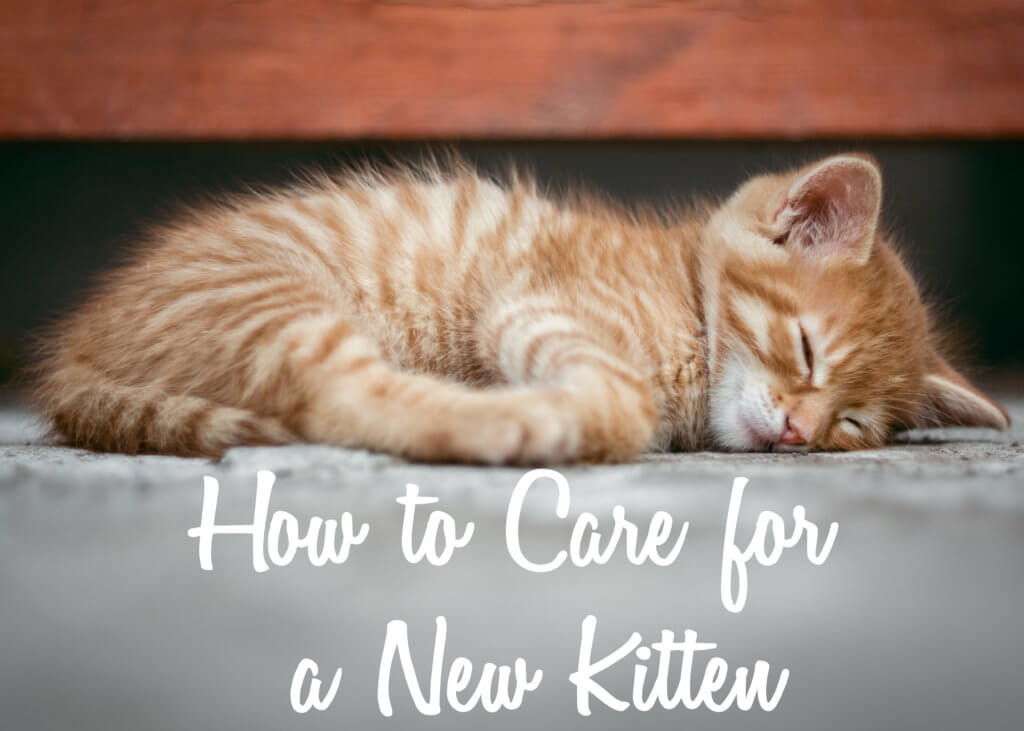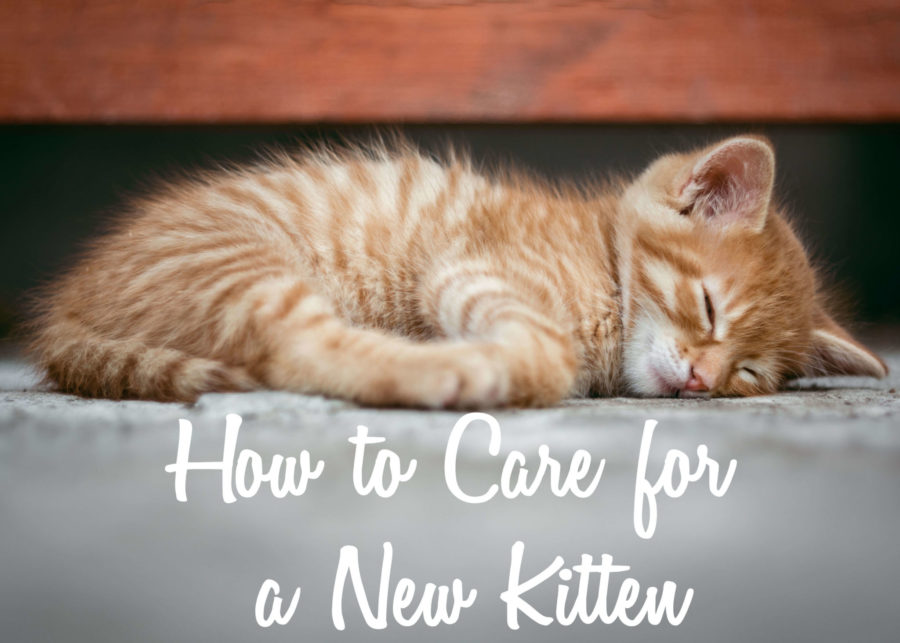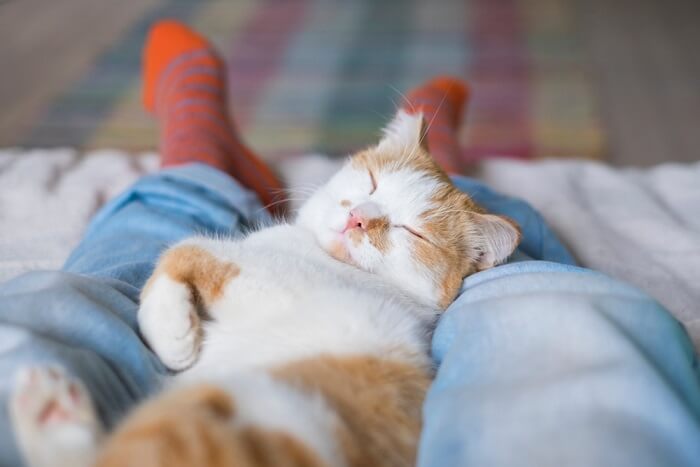How To Care For A New Kitten?
This page contains affiliate links. We may earn money or products from the companies mentioned in this post through our independently chosen links, which earn us a commission. Learn More

Bringing home a cute and cuddly ball of fur can be exciting, but keeping him happy and safe will take a team effort from the entire household. Your kitten will be completely dependent on you while transitioning in to his unfamiliar new place.
Unlike adult cats, kittens require a lot more care and supervision because of their curious and active nature. Here are several tips on how to care for a new kitten and make your new kitten’s arrival easier.
How To Bottle Feed A Kitten?
Bottle feeding is done to enhance nutrition especially if the kitten is in bad condition or if the mother is no longer present. Usually, bottle feeding is necessary with cats or kittens that have gone through nutritional trauma. Your veterinarian can help in determining what is needed on a case by case basis.
For newborn kitten care, you will need K.M.R. ( kitten milk replacement), which you can usually find at pet stores or you can order Petag PMR from Amazon. A specialized bottle will help feed the kittens the milk replacement.
Bottle kits designed for feeding kittens are available at most pet supply stores or you may want to consider these veterinarian designed bottles by Sleeky. Instructions on preparing the nipples and milk are usually provided on the packaging. Nipple openings should not be too large or wide and you will need to sterilize your kitten’s feeding bottles between feedings.
A kitten should eat about 8 milliliters (mls) of formula per ounce of body weight per day. To feed, use 1 part powdered KMR formula to 2 parts water and mix or shake in the bottle. Always underfeed a kitten rather than over feed. It is safer to give more frequent, smaller feedings than a few large ones. Over-feeding leads to colic and bloat.
Use the following chart as a general reference for feeding your kitten:
|
Age |
Weight |
Amount per feeding |
Feeding schedule |
|
0-1 week |
50-150 grams |
2-6 ml |
Every 2 hours |
|
1-2 weeks |
150-250 grams |
6-10 ml |
Every 2-3 hours |
|
2-3 weeks |
250-350 grams |
10-14 ml |
Every 3-4 hours |
|
3-4 weeks |
350-450 grams |
14-18 ml |
Every 4-5 hours |
|
4-5 weeks |
450-550 grams |
18-22 ml |
Every 5-6 hours |
|
5-8 weeks |
550-850 grams |
(weaning; offer ample wet food) |
Every 6 hours |
You may need to warm the formula by placing it in a bowl with hot water. K.M.R. formula should be warmed to 100 degrees Fahrenheit before feeding. Always test the temperature on your wrist are before giving it to the kittens. A meat or baking thermometer can also be used to determine the temperature of the milk.
When feeding, you may want to sit with a towel in your lap with the kitten facing you. Never feed the kitten on his back. The kitten should be on his stomach in a position similar to how he would lay next to his mother to nurse. Start by turning the bottle upside down and allowing a drop of formula to come out.
Place the bottle nipple in the kitten’s mouth while gently moving it back and forth, holding the bottle at a 45-degree angle to keep air from getting into the kitten’s stomach. This process should encourage the kitten to start eating. If it does not, try rubbing the kittens head to replicate his mothers licks.
Newborn kittens, up to 1 week old, should be fed every 2 to 3 hours and by 2 weeks old, every 4-6 hours. Once they are 3 weeks old, they can be fed every 4 to 6 hours.
Continue to use the rule of 8 milliliters of formula per ounce of body weight per day, as described above, to determine the amount of food the kitten should be ingesting or follow the provided chart. Always clean the kittens face and wash your hands when you are done with feedings.
After bottle feeding or nursing, most kittens are likely to want to sleep but kittens need to be burped, just like human babies. Lay the kitten on his stomach, using your shoulder or lap, and gently pat his back until you hear a little burp. You may need to burp kittens a couple times per feeding.
Helping Kittens “Go”
Mother cats stimulate kittens to go to the bathroom by licking them. If the mother cat is still around, allow her to do her job by licking the kittens to stimulate them in going. If you are caring for an orphan, you will need to help them by stimulating them at each feeding.
Use a soft and disposable cloth like toilet paper, wet or dry works,while holding the kitten steady with one hand, then gently rubbing the genital area in a circular motion. The kitten should begin to pee and you should keep rubbing until he is done. This process can also be used near the bottom area if the kitten needs to poop.
How To Wean A Bottle Fed Kitten?
Weaning is a process where most kittens are slowly introduced to a solid cat food diet while withdrawing from the usual feeding of its mother’s milk or bottle feedings, just like in humans.
Normally kittens begin solids at 7 or 8 weeks, but the process of weaning usually begins during the 4th week. Try offering the kittens formula on a spoon and once they are lapping it off the spoon, try putting some formula in a saucer. You may also want to try giving kittens solid wet cat food in the formula in the saucer. During this time you will still need to bottle feed them.
As the kittens adjust to eating wet food, you will need to also add more water to the formula mix. As the kittens eat more solid cat food and less formula, you will need to have a bowl of fresh water available for them at all times to keep them well hydrated.
During this time, you may also add a dry kitten food to their diet. Pay attention to your kittens’ stools to assure they are tolerating the new food well. If diarrhea or constipation becomes an issue with the change in diet, contact your veterinarian.
Conclusion
Taking care of a newborn kitten is fun and exciting, but proper kitten care is vital to the health and development of your kitten. Monitor your kittens and make sure they are gaining 1/4 to 1/2 ounce per day. If you have any concerns about the health of your kittens, it is imperative you contact a veterinarian immediately.
Must Have Items
- Food and water bowls
- A litter box
- Break away collar
- A lot of small safe toys and a cat tree to promote exercise and safety
- Bed lined with a warm blankets
- Grooming items like a brush & nail trimmer
- Cat carrier
- ID tag or implanted microchip to ensure your cat doesn’t get lost
Choose A Veterinarian
The first thing you should do is have your new kitten examined by a veterinarian to make sure there are no health issues. Intestinal parasites are very common in kittens and determined by fecal examinations. Treatments are administered and repeated until two consecutive fecal examinations are negative.
External parasites, such as fleas, ticks and mites, are treated with kitten safe remedies.
Kittens do receive some immunity from their mothers at birth and through nursing, but this immunity slowly wears off. Therefore, at eight weeks your kitten should be vaccinated as well as be ready to be spayed or neutered. It is also a good idea to have your kitten micro-chipped.
Provide High Quality Food
Your kitten’s diet should come from high-quality dry and wet foods that are packed with protein and essential amino acids to provide nutritional support. At six to seven weeks of age, kittens should be able to chew dry food which is convenient because it doesn’t spoil. Since kittens do not devour their food in one sitting, food can be left out. Talk with your veterinarian to determine to right type of food for your kitten.
Always Provide Fresh Water
Make sure fresh, clean water is available to your kitten at all times. The bowl should be low enough for the kitten to be able to drink from it easily. Because kittens sometimes like playing in the water a heavy bowl maybe required to prevent tipping.
Designate a Room
You will want to set up a secluded room, away from other animals, for kitty to adjust to his new home. This room should have a door, litter box, water and food bowls, toys and warm bedding.
If your kitty is having a problem sleeping, visit http://affectivebrain.com/?attachment_id=5775 try wrapping a ticking clock in a blanket near his bed to remind him of his mothers heart beat. Make sure kitty has lots of blankets in his bed because their bodies are too small to retain body heat well. Always place the litter box as far away from kitty’s food as possible because even kittens don’t want to eat near their toilet!
Establish A Feeding Routine
Depending on age, kittens should be feed between 2–4 times a day. Generally speaking, if your kitten is between three and six months old you can feed him three times per day, and once he turns six months old, you can feed him twice daily. It is essential that you monitor your kitten’s eating habits to keep him healthy. A decrease in eating means you should seek medical advice.
Do not be alarmed if your new kitten is not eating or drinking right away. Be sure and have food and water available for him at all times in a calm, quiet place and eventually they will start eating and drinking. Sometimes it takes kittens a day or two to start eating due to stress.
Introduce The Litter Box
Your kitten’s litter box should be placed in a secluded corner of his room and the sides should be low enough for him to get into. Anytime your kitty has finished eating, or awakened from a catnap, put him in the litter box.
If he doesn’t take to it naturally, take a paw and show him how to dig. Praise him if he uses the litter box and never punish him if he doesn’t. Use regular litter, not the clumping kind because kittens can lick and swallow the clumps causing blockages in their digestive track.
When your kitten is 3 months old, they can safely use the clumping litter. Remember to keep the litter box clean to encourage your kitten in good litter box habits.
Playtime
Play time is very important for your kitten’s social and physical skills. Try to provide him with gentle interaction and refrain from rough play which can lead to aggression. Offer your kitten rolling ping-pong balls, dangling feathers or a toy on the end of a rod. Your kitten may even enjoy a laser pointer toy or remote-controlled toys.
Kittens like to hide and retreat at times which makes cardboard boxes and paper bags ideal. Consider getting your kitten a scratching post made of carpet or cardboard to discourage him from using furniture or carpet. Providing the right equipment and training to your kitten will help avoid a lot of future damage and frustration.
Kitten Proof Your Home
Kittens are clever and curious which means their owners must keep them safe from harm. To kitten proof your home, start by placing all house plants out of reach and making sure all cabinets with household cleaning items are locked up.
Prevent chewing on electric cords by bundling them up with a cord manager and fastening them away from your kitten’s reach. Items like rubber bands, string, jewelry, holiday decorations, plastic bags, balloons and other small items can be dangerous if swallowed.
In the laundry room, keep washer and dryer doors closed so that your kitten does not climb in for a warm nap. The toilet seat lid should always be kept down to prevent your kitten from drowning or being poisoned by drinking water that may contain cleaning chemicals.
Introducing Kitty To The Family
Limit handling your kitty for the first few days while he adjusts and introduce one family member at a time. Children under five should not interact with kittens alone because children can be rough and sometimes tragically. Older children should be taught how to hold a kitten with one hand just behind the front legs and the other supporting his hindquarters. They should be taught never to grab a kitten’s tail or ears, or pick him up by its scruff.
If you have other cats, be sure they have been checked by your vet and are disease-free. While your kitten is in his room, allow your other cat to sniff around the doorway. Be sure and give your cat extra attention to ease his own anxiety about the new kitten.
Once your kitten seems comfortable, allow the two to meet in small increments. Allow them to sniff and explore each other while supervised. Hissing and growling is normal but if one cat shows aggression, separate them and try again in a few days.
If you have a dog in your home, do not leave him alone with the new kitten. Make sure your dog is leashed when you introduce him to your kitten. This will allow them to learn each others scent safely. Try to prevent the kitten from running away or it may become a game of chase for the dog. Reward your pets for good and calm behavior.
Conclusion
This can be a fun and exciting time as you get to know you new furry family member. If this is your first experience with a kitten you may want to take the time to read a book about kitten care that can provide far more details than this article provides.





Kwasi Amponsah
Learned soooo much about taking care of my new kitten from this blog post! It's so informative! If anyone's looking for a new cat condo for their little one, I found the coolest little design on here: https://www.amazon.com/PawzUp-Premium-Activity-Sisal-Covered-Scratching/dp/B07WRGVPP1/ref=sr_1_1?keywords=pawzup&qid=1580167320&sr=8-1 It's super cheap too! Good luck with your new kittens everyone!